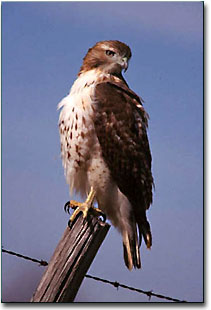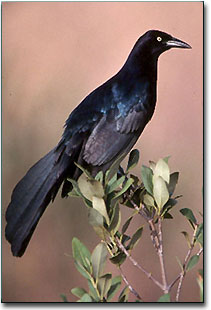
Are you thinking about buying an expensive portable blind so you can finally get close enough to wild birds to create a decent photo? Hold on a minute, you probably already own one of the best blinds around -- your vehicle. The reason photographers use blinds in the first place is because birds usually view a human on the ground as a predator. Stay in your vehicle and you become an odd intrusion, but not one that is particularly threatening. Using a close focusing 300 to 600MM telephoto, combined with a good quality telecoverter, you can often approach close enough to fill the frame with your subject and to capture some behavior. Here are some field-tested ideas that can make this technique work for you.
Equipment
Turn your vehicle into a tripod. I use a lens and camera support that hooks over my window and braces against the outside of the driver's door. On top of the small platform I use either a simple beanbag with my 300mm lens nestled down on top, or a good solid ball head with the larger 500mm lens. There are a couple of commercial manufacturers of window supports. I use the Kirk Window Mount. Leonard Rue also makes a good one called The Groofwin Pod. The primary consideration with a ball head is freedom of movement. You need to select a support that allows you to quickly change camera angles or to swivel, while continuing to provide solid support. I have tried using less expensive ball heads and found them to be an exercise in frustration. By the time I got the ball head adjusted, the bird had changed position, or left altogether. I recommend using just a good solid support like the Kirk or Lee Rue and a beanbag with a lighter lens, or use a ballhead with your support that has a simple control with adjustable tension like the Arca Swiss B1 for the heavier super-telephotos.
Technique

I like to use the driver's side window. When you are ready to shoot, turn off the engine to avoid vibration. You and any passengers need to hold still when photographing. Avoid quick stops that turn your vehicle back into a perceived threat for birds. If you fail to spot a bird until you are alongside, go on past and retry a more deliberate approach.
Be ready to shoot. Once you are alongside your subject, you may only get a few seconds before the bird moves off. When you spot a subject ahead of you, stop and make sure that your support is in place and set at the angle you estimate for your subject position. Also insure that your camera is ready to operate and loaded with film. Once that is done, you can make your approach. Keep your movements to a minimum. A fast motor drive is also helpful, as well as plenty of new film within arms reach. Use a lens shade if you have one. A word of caution when you are driving, take the support and camera out of the window. Sensitive autofocus cameras and lenses don't fare well after falling to the ground from moving vehicles, not to mention the dust!
A more naturally colored vehicle like a beige color, light green or light blue seems slightly better than bright or dark colors. (Don't let this one keep you out of the field if your vehicle is a bright color -- my truck is fire engine red!)
Feeding birds are more easily approached. I once drove up within twenty feet of a Red Tailed Hawk on a fence post. Generally the large raptors will not allow a photographer to approach this close. After taking a number of photos, the hawk jumped down in the grass and grabbed a mouse it had been watching. My subject apparently did not intend to allow a photographer to ruin his meal. Insectivores and seedeaters will also allow a closer approach when feeding. A good pair of binoculars are a great aid for observing behavior and identifying the species before you approach.
Safety
Safety is of paramount concern! This is NOT a technique to use on paved, high traffic roadways. You should consider only rural, unpaved, low traffic roads for this technique. Not just for safety, but because that is where the more interesting birds can be found close to the road. It is a good idea to carry a passenger that once your vehicle is safely parked on the side of the road, can watch the road for traffic while your eye is in the viewfinder. If you can find an accomplice that can drive while you photograph and anticipate your needs for positioning the vehicle, this is probably the safest way to use a vehicle. If not, you must concentrate on your driving first and foremost. Remember, oncoming vehicles cannot see you if you pull over on blind curves or steep hilltops, and quick stops when you spot a subject are not advised. Finally, I do not drive off-road in unfenced, sensitive wildlife areas. No photograph justifies driving over a ground nest, or otherwise tearing up the land. Not to mention that it is illegal in most areas.

How to Locate Birds
Does all this effort produce good results? You bet it does! My favorite locations in Northeastern Oklahoma are The Nature Conservancy's Tall Grass Prairie, and the rural roads around the Barren Fork and Illinois Rivers. I have photographed many species of birds using this technique. In many of my shots the birds were perched on fence wire and posts -- these are favorite spots to perch on the prairie. Regardless of your location, you should look in rural areas where you have observed birds perched along the road, or check out areas where there is water or opportunities for feeding, like corn or wheat fields. Warm, late afternoon light seems more conducive to roosting behavior and more dramatic photos. Backlit, silhouetted birds can make wonderful compositions. In Oklahoma, one of my favorite times is the date when the insectivores migrate back into the area, usually May. Check with your local Audubon Chapter to determine what seasons are best for your area's bird species.
Needless to say, stationary blinds have their uses. However, if you are using a traditional blind, you are have to pre-select an area for that days shoot. Your opportunities occur only if you have selected a suitable location and are extremely patient. Using your vehicle as a blind allows you to have an important advantage - mobility. Instead of waiting for your subjects to move into range of your lens, you can move yourself closer to them. If you use the right technique combined with a concern for safety and ethics, your vehicle is a highly effective way to get close to wild birds. One more advantage - I find photographing from my truck much more enjoyable than crouching in an overheated, airless blind for hours.
Nothing can totally replace the great feeling of walking or hiking in a natural environment. However, if you want to get close to a variety of wild bird species along the roadside, try using the blind you already own. You can capture an amazing variety of avian images by simply using your vehicle!
About the images...
Red Tailed Hawk
This hawk allowed my truck to approach close enough for a photograph because he had spotted a field mouse in the grass right below this fencepost. Shortly after this shot was made he jumped down and captured the mouse and flew off before I could get my eye back to the viewfinder. Canon A2 and 300MM F4 IS with 1.4x extender, AV mode at F5.6.
Dickcissel on Branch
This cheerful little bird inhabits open fields and meadows in the Midwest. This one was photographed on the Nature Conservancy's Tall Grass Prairie Preserve in early morning light. Canon EOS3 and 500MM F4 IS with 2x converter, AV mode at F8.
Great Tailed Grackle
This male specimen posed for me along a gravel road near a marsh in Port Isabel Texas. He was displaying for the benefit of some nearby females in early March. Canon EOS3 and 500 F4 IS in AV mode at F4.
Editor's note: Colin Smith is a NPN reader who resides in the state of Oklahoma.

